_I asked Cat where she wanted to have our anniversary dinner and she said she'd been craving Japanese. And when it comes to Japanese food, Hanakazu will always be among the first restaurants I'll think of.
This traditional Japanese restaurant along Aguirre (near the Elizalde stoplight) -- now entering its seventh year of business -- is helmed by none other than the former chef of the posh Tsukiji restaurant in Makati, Hiroaki Otsuka. If you're a fan of Japanese food you'll already know what that means; if not, then let us quote you what they've put at the front page of their menu: "Fresh Sushi. Delectable sashimi. Crispy tempura. Tender Beef Sukiyaki. Mouth-watering Ebi Ten Maki." The descriptions do not exaggerate. From a small restaurant, Hanakazu has expanded its space to accommodate its growing clientele, a testament to Chef Otsuka's labor of love.
We ordered a perennial favorite, the Ebi Ten Maki, a sushi roll tenderly cradling crisp ebi tempura slices in its center; Miso Soup; a refreshing Kani Salad; Yakiniku (grilled beef); and Yakimeshi (fried rice).
All the dishes were made to the high standard that this popular restaurant has come to be known for -- all the ingredients are top-grade and fresh, the flavors light and ethereal, very well balanced -- you can see the chef's expertise in the way every roll of sushi here is rolled just so, the sashimi cut so neatly you'd swear fish grow in neat rectangles and lozenges.
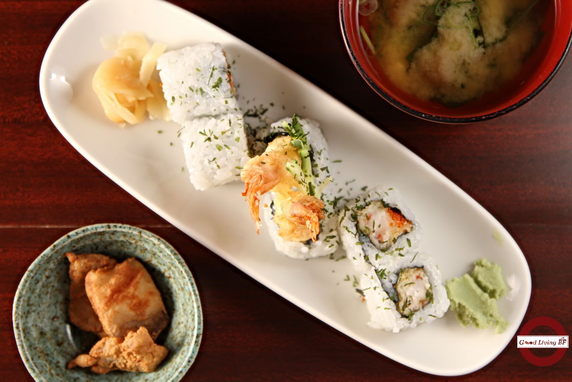 Ebi Ten Maki with Maguro Tatsutaage and Miso soup _As I said, we nearly always order the Ebi Ten Maki when we eat here; Hiroaki's wife Lorna says she's not sure whether this roll is Hiroaki's own invention or not, but she does get comments from foodies telling her Hanakazu's version is the best they've had. I agree. We also received tiny bowls of Maguro Tatsutaage, breaded tuna slices fried crisp, as a complementary appetizer.
A new revelation for us was the Kani Salad, a beautiful light salad of lettuce and assorted greens, carrots, and kani strips, tossed in a light semi-sweet mayo dressing and topped with strips of dried seaweed. The serving of this salad was surprisingly large, easily good for sharing among three or four. On its own, it can make a pretty filling meal for a health-conscious diner. We also loved our Yakiniku, the beef so tender we could tear apart the strips easily with our chopsticks, with a light soy-pepper-slightly-sweet flavor. The beef went perfectly with our sticky Yakimeshi.
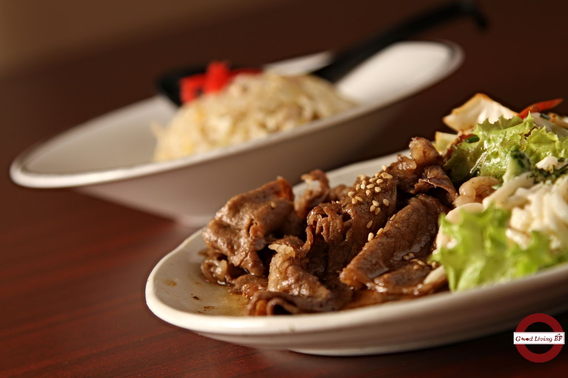 Yakiniku with Yakimeshi  Kani Salad _Chef Hiroaki was too busy to interrupt, but we were able to get Lorna Otsuka to drop by our tatami room and tell us more about Hanakazu. The restaurant's name is taken from their daughters, Hana and Kazuko. They and their two sons, Yoshi and Sachi (after whom the two tatami rooms are named), are the reason Chef Hiroaki is happy in BF Homes rather than taking up offers to open a Hanakazu branch in commercial districts like Makati. "We were tempted by an offer when Serendra was new, but when we found that we'd have to be open all week, my husband said no," reveals Lorna. "He wants his Mondays off, because that's his day to be with his children. That's the day he'll make them lunch himself as a treat."
The rest of the week, though, is spent keeping up the quality that Hanakazu's become known for. Though the restaurant opens at 11:30 a.m., Hiroaki arrives early to begin making the ramen broth, which he insists on making fresh every day. He also does the marketing for ingredients himself every three days, and they regularly receive shipments of locally hard-to-find items from Japan.
That passionate attention to detail is evident in every bite here at Hanakazu, which is why we've been regular customers since 2005. The staff even remembers my friends and I as "that noisy gang that always makes such a ruckus in the tatami room but orders a lot!", said with a smile, of course. Lorna said that their loyal customers now have "Hanakazu babies" -- you could say that we could count ourselves among them as well.
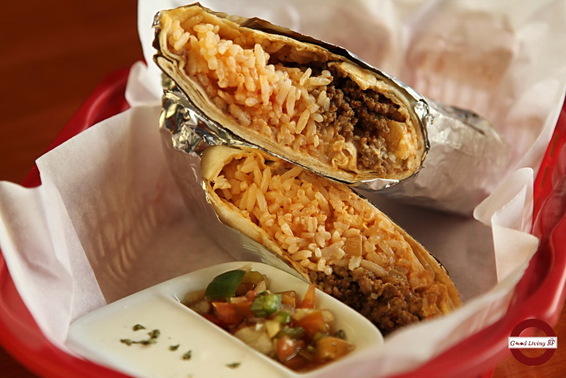 Beef Burrito _I found another hidden treasure of BF Homes earlier this month when, on impulse, I decided to eat at Mexan one evening I felt too lazy to cook. This little restaurant is tucked away on the side of The Pergola Mall facing the Ruins bazaar, a side I rarely go to, and would've slipped beneath my radar if not for the placard they'd put at the mall's front entrance.
First impressions on entering: the place will only sit about a dozen or so people at a time, but the interior is very tastefully done in bright pueblo colors; there's Spanish guitar music on, and the only occupied table (it was early for dinner) was occupied by an expat. He looked happy with his burrito, so I got one too. Surprise! My Burger Burrito had a good proportion of meat to rice, wrapped in a nice fresh tortilla, and the flavors were bright and right. The cook, whoever he or she was, knew enough not to hold back on the cumin and other spices, so the burrito's contents had a really nice aroma. This was served with a side of sour cream for dipping and some fresh onion and tomato salsa. I had to take Cathy here! I also got to meet one of the proprietors, Dia Velazquez, so we scheduled a shoot with her.
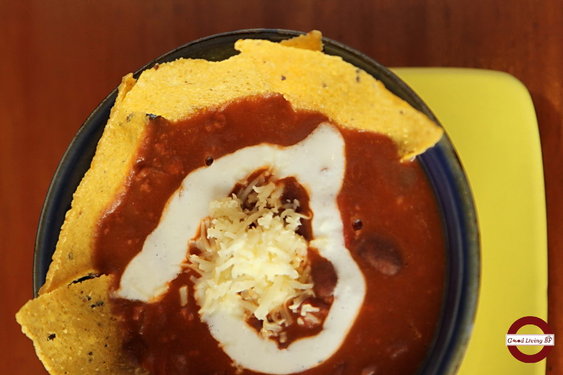 Chili Con Carne _On our third visit, owners Dia Velazquez, Joanne Sta. Maria and Tess Vinluan were there to greet us and give us a sampling of their bestsellers. We got to try the Chili con Carne, Beef Burrito, and Buffalo Wings. The burrito was a known quantity - I'd had it before, and I knew I'd always have one when I eat here. It's flavorful and filling, but my personal favorite remains the Burger Burrito -- also beef, but maybe the ground meat or the way they cook it makes it taste even meatier. The Chili con Carne was exactly that -- hot! Just the way I like it! Again, I liked the fact that they didn't stint with the spices, and again, the proportion of meat to beans was just right. And did I say it was hot?
The best dish of the lot for both Cat and me, however, was the Buffalo Wings. It's the kind of dish you dig into with your fingers, gnaw on the bones for as long as you can still get some flavor from them, then lick your fingers afterward. Crunchy even when we ate it a little cold (in between the interview) and served with a sour-cream dip instead of the usual blue cheese or Cajun sauce, the wings had just the right blend of sweetness, a mild heat, with the tanginess of the sour cream rounding out the flavors. It will keep you coming back for more.
I had to buy a take-home pack for my dad -- it made a good excuse to have a few more! Also, the order is quite big; while on the menu it's describes as five pieces, Joanne says this is based on the number of wings that go into each order. Since they halve each wing, an order comes to ten pieces -- if you're having this as appetizer, it's good for a group of three or four. We had our food with iced tea, but for those who want it, there's also good old San Mig beer, Corona beer from Mexico, sodas, margaritas, zombies, and of course, tequila shots available.
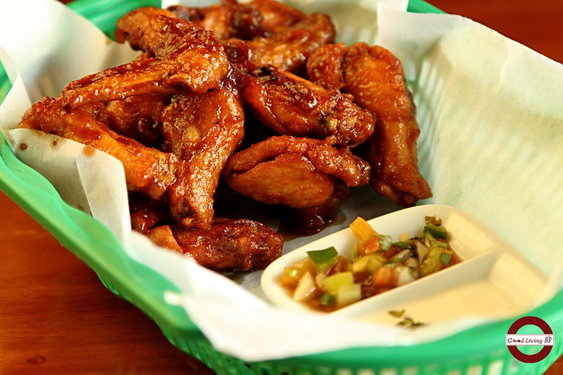 Buffalo Wings _There are no Mexicans, or even Texans, involved in this restaurant at all. Instead, Mexan is the brainchild of Dia and Joanne -- credit for the name goes to Dia’s son Migs -- who, along with Tess, share the responsibilities of running the restaurant, developing recipes and taste-testing, with one another. Although they only opened at The Pergola Mall last April, they've been doing Mexican food for six years, with a food stall in La Salle Zobel. "We were a hit with the kids, because the way we cook is we're always thinking we're doing this for our own families," says Joanne. "We developed our recipes together, researching recipes then testing and combining until we got what we wanted. Being moms, we knew what kids wanted."
The buffalo wings got added to the Mexican lineup, Dia says, when they were talking to the mall management. Taking the suggestion of combining the concepts instead of getting a separate stall for the wings, they quickly found the wings to be a bestseller too, along with their burritos, and soft tacos. The popularity of the latter two has led to additional sizes, junior burritos and large tacos.
Perhaps the best validation for Mexan's taste is the number of expats who've been coming back as repeat customers. "There was this American who ate here one day and he kept whispering to his Filipina wife. It turned out he was a Texan, and he liked the food so much he wanted to order another!"
Perhaps, we have The Pergola Mall to thank for for offering them a bigger space than their initial plan for a just a food stall. It's given the entrepreneurial moms the creative space to come up with their culinary best.
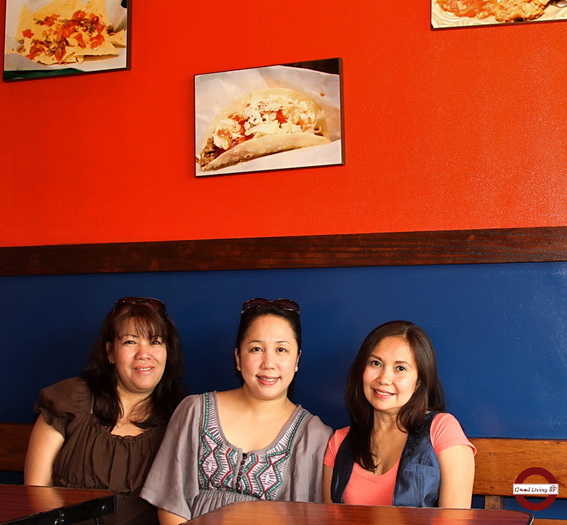 Tess Vinluan, Dia Velasquez, Joanne Sta. Maria
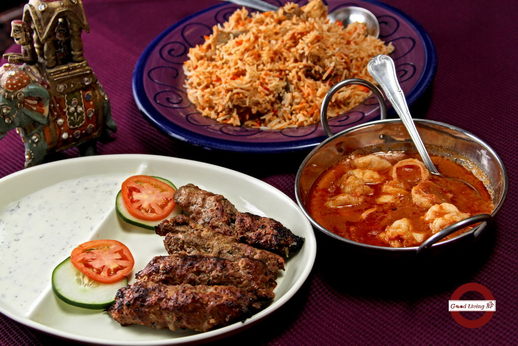 Beef Kababs, Chicken Biryani, Prawn Curry
When I was fifteen and living in New Delhi with my parents, I'd often get off the schoolbus a few blocks before our street and walk home from there so I could pass by the local bakery. I'd pick up half a dozen piping-hot vegetable samosas, make half of them disappear, and arrive home with a cheery 'Hey Mom, Dad, look! I got us samosas -- one each!'
My first bite of Raaz Mahal's vegetable samosas inevitably brought back this memory, as fresh and sharp as it was yesterday (Hey, it's not been that long ago! Uh, yeah riiiight.). I guess another reason this memory got triggered was because our first visit to Raaz Mahal was at my dad's invitation, his treat for me on my birthday. The two of us have had a real weakness for Indian cuisine ever since that stint in Delhi, and as Raaz Mahal serves Punjabi food, the same North Indian food we got used to, we're really happy we've now got a restaurant like this in BF. A few days later, Cat and I visited again to interview the Arshad family, Raaz Mahal's owners, and of course to eat more samosas.
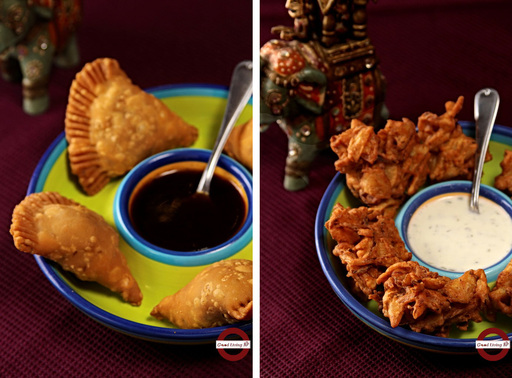 Vegetable Samosas and Potato Pakoras Ordering for the family, I went for the tried and true appetizers: Vegetable Samosas, Onion and Potato Pakoras, and cheese-filled Aloo (Potato) Balls. We followed this up with the Chicken Dal, Chapatti bread to scoop up the dal with, Beef Kababs, Prawn Curry, and Chicken Biryani, and on our return visit, we tried the Goat Korma and Naan.
The great delight of Indian food, for me, is the way the complex blend of spices, the masalas, create a cascading explosion of flavors on the palate and the nose. This is exactly what we got with Raaz Mahal's food. The Samosas were crisp on the outside, soft and delicately spiced inside, and served with a sweet and tangy chutney sauce. The Pakoras were also crisp, really nicely done -- flavorful, not oily at all despite their being deep-fried -- and went great with the provided chili dip. The kids went bananas over the Aloo Balls, which were like potato croquettes filled with an herbed cottage cheese, and also served with chili dip.
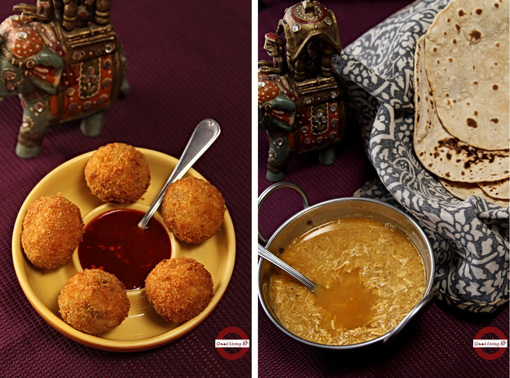 Aloo Balls and Chicken Dal with Chapatti
I would've liked more lentils in the Chicken Dal, which was a lentil-and-chicken stew with curry spices. You scoop it up with torn pieces of Chapatti bread or Naan. The Beef Kababs and Prawn Curry came next, and disappeared very quickly! The kababs were delicately spiced, still moist inside (ground meat kababs dry easily, so this tells me the cook has a light hand on the grill), and served with a yogurt-mint-and-coriander-leaf sauce that surprisingly turned out to be the spiciest thing on the table, heat-wise. The Prawn Curry was buttery and had just the right amount of heat for the family -- strong enough that you could tell this was real Indian food, yet toned to the level that my sister and nieces could still taste everything. And the prawns were very fresh -- they had that sweet fresh taste. Because of the strong sauce of the kabab and the prawn curry, I'm afraid I wasn't able to really isolate the flavor of the biryani very well; it was very fragrant though, and yes, it was made with real basmati rice.
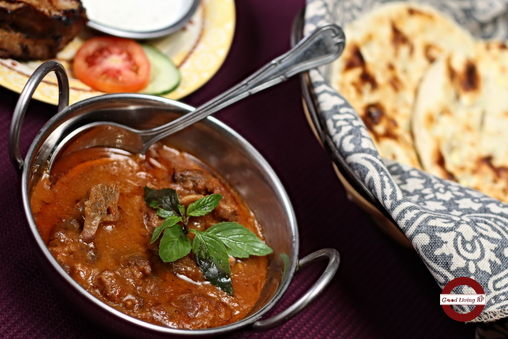 Goat Korma with Naan I wish though that I'd thought to order the Korma while my whole family was there. That was a knockout! The yogurt-based sauce was very rich and creamy, nicely aromatic with the distinct yet far from overpowering mutton scent that tells you this isn't beef or pork. (Raaz Mahal is owned by a Pakistani family and serves Halal food). If I had to recommend a dish with which to break the common Pinoy aversion to goat or mutton, this korma would be high on the list, if not first. We chose to have this curry with Naan bread instead of rice, and I'm happy to report that Raaz Mahal's naan is the kind made with sesame seeds, giving them a nice added crunch.
I just wish the portions were bigger, a concern that manager Shala Arshad assures me will be dealt with when they come out with their new menu. Now that they know their market and are more confident that their food sells, Shala says, they're ready to upgrade the 'sampler' portions to something larger. Raaz Mahal is not a cheap place to eat, but given the complexity of their dishes, and the fact that all the spices they use must be imported from Pakistan, you know what you're buying.
Shala, her brother Ismail (Ish), the chef, and their father Muhammad sat with us as we were wolfing down the korma to tell us Raaz Mahal's story. The name Raaz Mahal means 'Secret Palace' or 'Mysterious Palace,' and fits right in with the tasteful, very Indian theme of the interiors. The Arshads own the Orientique furniture and antiques stores, and it shows. Raaz Mahal's interiors are painted in the gay hues of a bazaar in Rajasthan, and studded with plaques and statuettes done in traditional Indo-Persian motifs.
Nor are the Arshads newbies at the restaurant business, having opened one in Jakarta sixteen years ago, and another in Lahore. In fact, Shala says, the very reason for Raaz Mahal's existence is the love she and Ish have for their dad's cooking, which is based on traditional Muslim Punjabi recipes. But when he finally caved in to their insistent clamor for a restaurant here in Manila, it was Muhammad Arshad who chose Aguirre Avenue as their first location; a tribute to the burgeoning BF Homes food culture.
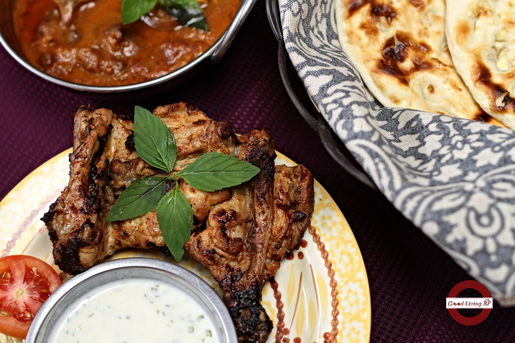 Chicken Tikka
We finished our meal the same way we did on the previous visit, with a Strawberry Lassi. This sweet iced drink, with just the right amount of fresh strawberry and yogurt tartness, clears the palate beautifully after a meal rich in heady masalas and ghee; not surprisingly it's one of their bestsellers. They also offer Mango and Banana Lassi, and we also tried their Kulfi; an ice-cream like dessert made with milk steeped with intoxicatingly fragrant cardamom and topped with crushed pistachios. Dairy-based desserts are very important when you eat hot food like Indian or Malay, as the milk clears the burning sensation from the tongue. (Alcohol intensifies it though; which is why, spice freak that I am, I had my appetizers and main course with San Mig Lite!).
Ish Arshad says, though, that we've yet to try their real signature dish, the Beef Nihari. It's a rich beef curry that takes all of seven hours to cook, and I can just imagine how richly developed its flavors should be from that treatment. Looks like Cat and I have something to look forward to!
 The Arshad Family
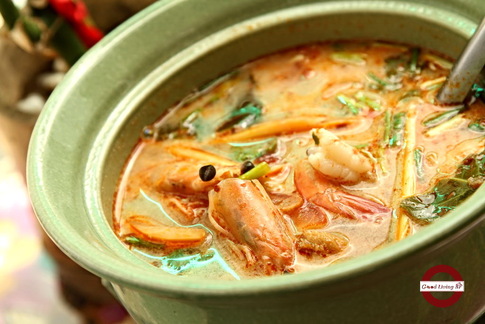 Tom Yum Goong There's a certain level of expectation you build when a restaurant's owner tells you they delayed opening until they had all the necessary herbs growing in their garden. That electric feeling of anticipation was just what I got when we first talked to Thai Fusion Cafe's genial owner, Don Reyes. Thai cuisine's unique flavor is built on a selection of fresh, aromatic herbs, so when a restaurateur tells you they grow their own, you know they're honestly passionate about their food.
Cat and I finally got to try Thai Fusion Cafe, and I'm glad to report that my expectations were met. No, more than that -- they were totally bowled over! Put it this way: If ever a typhoon catches you in here and Aguirre floods, you can just imagine that you're in Bangkok eating at this secret locals' place beside a klong. That's how I felt after sampling four of Thai Fusion Cafe's dishes -- Tom Yum Goong, Red Chicken Curry, Pad Thai, and Bagoong Rice with Sweet Pork. There's an elusive quality that just tells you a real Thai hand is behind a Thai dish--the balance of flavors, the bright freshness of the herbs and ingredients, the respect with which they treat the food. Not surprisingly, Don's secret weapon is his wife Patty, a Thai he met while working abroad.
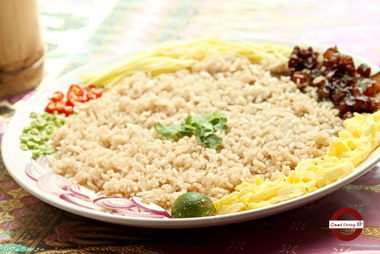 Bagoong Rice with Sweet Pork Thai Fusion Cafe, Don says, was five whole years in development: research, recipe testing, business studies; and yes, making sure their backyard herb garden could supply enough for a restaurant. Despite, or perhaps because of all that research, Thai Fusion Cafe has a very down-to-earth approach that lets you know this is a Thai place, while making you feel very much at home.
The interior of their new location, along Aguirre beside Arti's Boutique (the former site of Chi's) and near the Rodeo Spa, is simply yet tastefully done, with an atrium for al fresco dining that should be very inviting on clear December evenings. Subtle clues to the identity of the chef can be found in the decor -- not the mass-produced tapestries or paintings you'll find in Bangkok's tourist bazaars, but modern prints of signature Thai things such as kickboxing, temples, and portraits of the Thai royal family.
Then there's the earnest tagline Don uses to market his food--not 'authentic Thai', but 'home-cooked Thai cuisine.' Don's a great believer in letting the customer discover the quality of Thai Fusion Cafe as a delightful surprise and gratifying experience, a refreshing approach to branding compared to the hard-sell variety. He's even humble enough to warn that they can't always have everything available, or always produce a dish the same way all the time. That's why he's in no hurry to branch out even with offers on hand; to him quality, not quantity, is paramount and comes first.
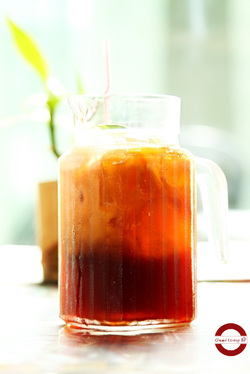 Thai Milk Tea (Jumbo size) Don had already revealed his aces -- herb garden, Thai wife -- when he asked how spicy I wanted my food, with a mischievous twinkle. I asked for their normal level of heat, and immediately got insurance by ordering some Thai Milk Tea; I knew I'd need it! Sure enough, Cat and I got the works! Even at mild levels Cat's eyes were going wide as she ate her Bagoong Rice with Sweet Pork. Me, spice addict that I am, I think I was pounding the table with joy over my Penang Curry.
First impression: these fresh, bright flavors are really possible only when you've got fresh Thai herbs to use, and the cook really knows what she's doing! The rich coconut milk sauce was smooth, creamy, shot through with sparks of unique flavor from the Thai basil and other fresh herbs in it. As for the chili level, as expected, their normal is a cut above what you might expect from Malay or Indonesian; which in turn is a cut stronger than North Indian, what I'm most used to. That Thai Milk Tea was indispensable! I had the curry with white rice, as per Don's advice, so I could enjoy the sauce's flavor to its fullest.
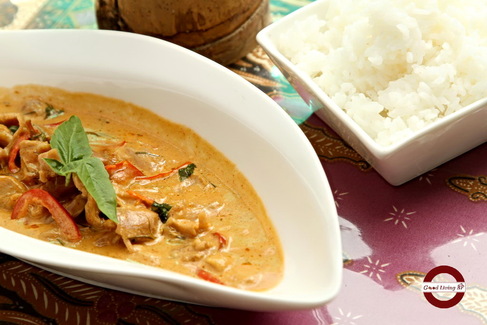 Red Chicken Curry (Penang) Same thing with the Tom Yum Goong, our usual benchmark for the quality of a Thai restaurant. It was a bright, complex interplay of herbs and contrasting flavors -- sweet, sour, salty, hot, savory -- and capped by the sweet light texture of very fresh prawns. Now, I'm allergic to crustaceans; the older the stock, the stronger its effect on me. My allergies remained quiet during and even after our meal, despite the soup having several split prawn heads in it for flavor. Conclusion: those prawns were still swimming a day or two ago. This guess was borne out by Don's assuring us that he's very meticulous about freshness, keeping only three days' worth of stock on hand at any time.
Cat was amazed by the complex balance of the soup, quite unlike the Tom Yums in her memory bank. Don speculates that may be because, left to their own devices, Filipino cooks tend to gravitate to the familiar flavor of sinigang and make their Tom Yum closer to our local soup by using less coconut milk and a much more conservative use of herbs. It was a gamble, he says, to introduce his wife's Tom Yum Goong because the Filipino market might already have been used to a modified, Filipinized version of Tom Yum. Me, I think that's a gamble Thai Fusion Cafe is going to win.
A note to the less adventurous -- Don stressed the importance of enjoying these dishes the Thai way. Many Thai offerings, such as the Bagoong Rice with Sweet Pork, have their flavors balanced in such a way that not eating everything on your plate will totally alter your experience. Under his guidance, Cat tossed the sweet stir-fried pork, scrambled egg, mango strips, chilis, chopped string beans and shallots into her rice, and immediately she tasted the difference. I tried it too, and yes, the flavors now came together like a harmonious gamelan symphony. Then we both grabbed our Milk Teas! I'm not sure if the chef was using Thai birdseye chilies or our siling labuyo, but a mere teaspoonful of the stuff is mighty powerful. One reason why the condiments are grouped apart on your plate, aside from the presentation's appeal, is so you can mix as much or as little of each as you want (although he says another reason for the compartmentalized presentation is that some customers may be allergic to some ingredients).
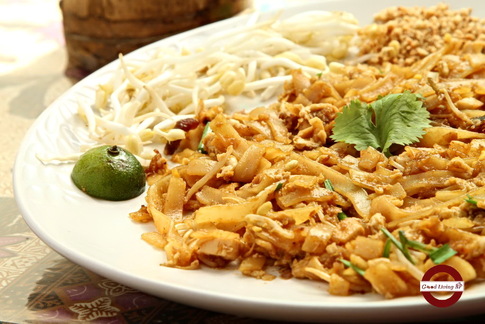 Pad Thai The Pad Thai arrived last, when we were already starting to feel full. That we left not even a single bean sprout, noodle or speck of ground peanut surviving on that plate should tell you how we found it! Don's recommended way of eating Pad Thai is to pair it with their Papaya Salad or with Satay, either chicken or pork. Pad Thai has become a favorite of some regulars' children, he says; maybe this is a good way to trick kids into eating their vegetables? It's also one totally non-spicy dish, so you've a fallback order if any of your friends or family are averse to chilies.
Thai Fusion Cafe was recommended to us by our friend Sheila Amora, owner of Funky Plum. She was so eager to have Good Living BF feature this restaurant, she even followed up a few days after texting us her recommendation. Now we know why. Had my mom been born Thai, I think this is how she'd have cooked. Honest, unpretentious, yet lovingly dedicated to quality. This is the real stuff!
You may also want to try their other bestsellers: Chicken Pandan, Thai Toast, (Fried) Glass Noodle Spring Rolls, Pork or Chicken Satay, and the Papaya Salad.
 Pia de la Fuente-Kasilag and Paolo de la Fuente BF Homes seems to have become an incubating ground for restaurant concepts of almost every type, with new restos mush- rooming along the length of Aguirre seemingly overnight. It's great for us residents to be sure, but I can only imagine the anxiety of current restaurant owners as the competition heats up. Who will last? Who will break out of BF and make it in Makati, or Malate, or Timog? One of the homegrown concepts I'd take a bet on is Mediterranean-inspired restaurant Pito & Mita, which opened doors around nine months ago.
We'd been hearing good things about this restaurant for some time, so it was with great anticipation that Cat and I went to try it out. Everyone recommends the Spinach Artichoke Dip with Melba Toast, so we tried that, while I got the Eggplant Lasagna and Cat the Parmesan-Crusted Baked Fish. All three are among Pito & Mita's bestsellers, co-owner Paolo de la Fuente tells me, and I soon see why.
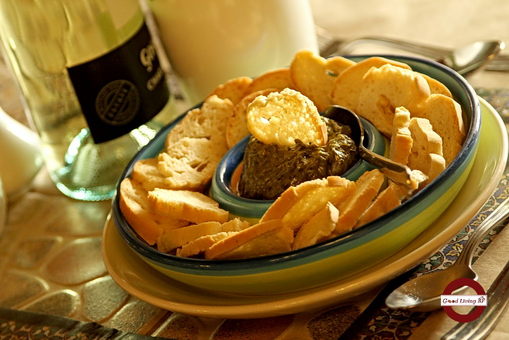 Spanish Artichoke Dip The Spinach Artichoke Dip is light and creamy, with a subtle and somewhat smokey flavor; I suspect they roast the garlic they put in it, and they put in just the right amount, enough to give it a kick but not so much as to overwhelm the delicate spinach and artichoke. I want chef Pia (de la Fuente-Kasilag, Paolo's sister) to start bottling this so I can have it on crackers when reading late at night! Add their sauces and dressings, too, that they make from scratch.
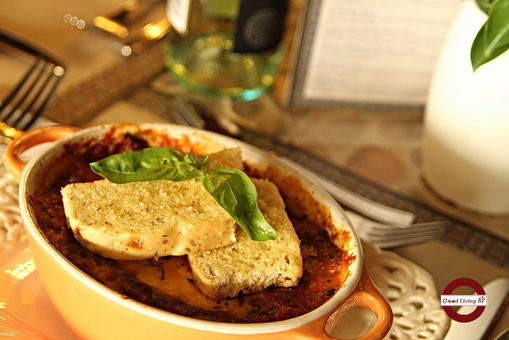 Eggplant Lasagna The Eggplant Lasagna is also a must-try, whether you're a vegetarian or a dyed-in-the-wool carnivore like myself. I love meat; I want the taste of meat with practically every meal; but as with Indian cuisine, I can go vegan on this dish and not miss the meat at all. The serving is quite generous, and though this is indeed a meatless dish, the hearty eggplant-tomato sauce and baked cheese crust together with the pasta make this a real belly-filler. Order this to share if you're a light eater.
 Parmesan-Crusted Baked Fish And if I thought the lasagna was good, the Parmesan-Crusted Baked Fish was even better (although Cat couldn't rave enough about the lasagna). This cream dory fillet was baked just right, so the flesh was firm yet melt-in-your-mouth tender, the whole thing crusted in a crisp thin shell of Parmesan cheese. Better yet, while this dish can be served with a side of rice, we had it with the Potato Gratin. Double the cheese is double the fun in my book, and when half of that is on baked potato I can get really mellow!
We may have gotten the crowd favorites but Pia isn't resting on her laurels but is constantly adding new dishes like their newest appetizers, Mushroom Alajillo, Shrimp Gambas & Assorted Grilled Sausages, and a third soup, Cream of Pumpkin. They have started to branch out to catering, just needing a two-week's notice from interested customers.
The secret behind Pito & Mita is chef Pia Kasilag's touch with her old family recipes. "A lot of what we serve in Pito & Mita is the food we grew up with at home," Paolo reveals. The de la Fuentes, it turns out, are a family of foodies with a special love for Spanish and Italian cuisine. After serving a stint as flight attendant in Northwest Airlines, Pia returned to set up the restaurant with Paolo, bringing in family favorites such as the Sopa de Pamplina, a Spanish-inspired soup that's the family's traditional Christmas soup; the Eggplant Lasagna; the Steak Salpicao; the Sicilian Chicken Salad; and the lemon-flavored Moringa juice that they serve as one of the house's recommended drinks. Cat and I washed down our meal with the Moringa juice, and found it very refreshing indeed -- fragrant, lemony, and not at all bitter as you might fear something made from malunggay might be.
And this I think is the reason Pito & Mita will be around for a while. Simple, hearty, delicious food, familiar enough for anyone to get into yet with that unique touch from recipes incubated in family tradition, and all that served _healthy_.
When we asked what has been their best experience so far, Pia said it was hearing rave reviews. "We never know what to expect from business so it's nice to hear good reviews especially from walk-in customers," she smiles. She can deservedly add this review to their growing list good feedbacks.
 Lamb satay There's a place in BF that serves lamb satay! Whee! That was my first reaction on reading the menu at Food de Sentosa, a Singaporean restaurant in Phase 3 that's been garnering quite a bit of attention lately. Business has been good so they are expanding the restaurant and adding five to six more tables next month.
Food de Sentosa is owned by Mr. Ronnie Teo, a Singaporean who's immigrated and married here. His son, David, turned out to be a co-teacher of mine at the College of Saint Benilde, but had to take a leave to help out at the restaurant due to the unexpected boom of demand there. He is now its full-time manager but you can also find him inside the kitchen helping his dad cook.
The elder Teo is a retiree who started the restaurant simply because he got bored after retirement. He had always loved cooking as a hobby and being the cook of the family, he brought in his family recipes as well as his own style of cooking and drew from Singapore's mixed Malay-Chinese heritage to build up Food de Sentosa's menu.
The eventual success of Food de Sentosa is one of life's quirks that just happens: With no business plan, no formal culinary training, no background in the food business, but armed only with a love of food and cooking, he launched his restaurant in November 2009. He never expected it would take off the way it has--they were even featured in the Philippine Daily Inquirer without their knowing a reviewer had visited--because he wasn't serious about it when he started, recalls David.
Today, they have regulars in and out of BF, like a fellow Singpaporean who travels all the way from Batangas just to eat there three to five times a week. Can you say Food de Sentosa addict?
One other reason for his success may be that Mr. Teo simply can't say no to any customer requests--he once cooked tempura for a customer. "Sometimes, he will cook something new on the spot and sometimes the dish would find its way to the menu the next day," David grins. He will also create new dishes with in-season ingredients like tom yao, kay lan, bok choy, and tang-o either from the local market or flown in from Singapore. (They also have kid-friendly dishes like Fried Fish Fillet with Chili Crab Sauce that's not spicy and custom-made prawn-flavored fried chicken).
 Nasi Goreng Cathy and I decided to try out the Lamb Satay -- hey, I never say no to lamb satay! -- the Black Pepper Beef, and the Nasi Goreng.
We loved the Lamb Satay, grilled to tender perfection and served with Mr. Teo's own traditional peanut sauce. Food de Sentosa's version of satay sauce is not as sweet as the Madurese version served in Pawon Ageng; I think it has more tamarind, and has a more herby aroma. Which do I like better? Give me both! Nobody ever died of a satay overdose, and one of these days when wifey is not watching I'm going to prove it! The sauce went very well with the unique aroma of lamb.
The Black Pepper Beef had a nice savory flavor, though not as hot as I would've expected from a Singaporean restaurant; unfortunately there were some tough bits.
I enjoyed the Nasi Goreng, Malay-style spiced fried rice with bits of meat, vegetables and egg, made savory with belachan, Malay dried shrimp. I rather wish the portion was a bit larger because we finished it before we could consume all the beef. The Nasi Goreng was really a meal in itself--a scrumptious one at that--so we could've gotten two and skipped the Black Pepper Beef.
I also wish I wasn't allergic to crab. A serving of chili crab went to the other table just as Cat and I finished eating, and the aroma simply grabbed me and almost made me forget I'd already eaten.
I've always said BF Homes needs more restaurants like these, and I'll say it again. Singaporean food is a great way for Pinoys to start sampling the wider galaxy of Asian cuisines, blending as it does the influences of Malaysian and Indian cuisine with the familiarity of Chinese, and Food de Sentosa is just the place for it.
One last detail: Why the color purple as the restaurant's theme color, we asked David. Because his dad didn't want the all-too familiar red, David laughs. Food de Sentosa's striking color was a great way to announce itself to the community a year-and-a-half ago, being the first restaurant here to use it in a big way. Today, his cooking and can-do attitude has endeared himself to his customers and has established his former hobby into a full-blown business.
Editors Note: We'd like to thank Ria Quintos-Ortega for reviewing Chic-Boy for Good Living BF.
SAVED BY THE FOOD
By Ria Quintos-Ortgega
I have heard many good things about Chic-boy from my friends and my party-legal children. I have been told me about their delicious Chicken Inasal and garlic rice with chicken oil poured over it with extra toasted garlic sprinkled on top. Doesn’t that just make your mouth water?!?! So I decided to bring my brood to the Chic-boy branch along President’s Avenue, BF Paranaque for dinner so I could see for myself what the fuss was about.
Let’s talk about what’s good about Chic-boy. First, parking was not a problem, considering it was a Sunday night, and the place was packed. There was more parking on the left side of the building too.
Second, the food was fantastic! Chic-boy is a play on the words Chicken and Baboy. We felt like the “boy” part of Chic-boy so we ordered the following items: My husband had the salmon sinigang, a double order of garlic rice, a double order of ginisang kangkong to share, and the Whole Cebu Lechon Liempo. My daughter ordered the SS-1 (Sizzling Special Meal Lechon Sisig served with rice and soup). My son and I both ordered a CB-6 (Chibog Busog Meal Cebu Lechon Liempo served with rice and soup).
The salmon sinigang was what I would like this dish to be. No scrimping on the salmon belly and soup sour enough to make your cheeks pucker. The garlic for the rice was toasted to perfection. The kangkong was very flavorful, well-seasoned and had the right crunch and color to it. The liempo is to die for with its delicious, well-marinated, juicy, succulent meat and crispy skin. It was lovely. The sisig was perfect - comparable to those served near the “riles” in Pampanga. There all sorts of textures at play with the softness and stickiness of the fat and crunch of the skin and the tenderness of whatever lean meat there is. Not to mention the added kick of the spicy sili! It was a rock concert in my mouth.
Third, Chic-boy is rice-all-you-can country! Yes, you read it right. This place serves unlimited rice. For those of you who are big fans of the stuff, the waiters go around carrying rice buckets, ready to plop a hot steaming heap of unadulterated carbohydrates onto your plate.
Lastly, you get great value for your money here. A very filling CB-6 meal costs P99. If you add a bottomless iced tea, it will come to about P124. Not bad at all!
Unfortunately, I do have some issues with Chic-boy, starting with the poor ventilation. The minute we walked through the door, the air was thick with the scent of barbecue smoke. It clung to my hair and my clothing. You must not shower before going here. Wait until after you get home or you’ll have to take another one if you do.
When we entered Chic-boy, we waited to be seated. The waiter approached us after a few seconds to tell us that we needed to place our order first, but we had to wait for a free table. He quickly added that there were people who were almost done anyway, so it shouldn’t be a problem.
Well, it was. After we had our orders efficiently taken by the person at the counter and was handed our order number, we had to look for a table. I approached one of the waiters and asked if there was a queue for seating. The reply was, “Wala po. First come, first serve.” I replied with, “That’s not a good idea.” People were circling the area for tables like vultures prowling for a meal. Some who came in after us got a table sooner just because they happened to stand next to some diners who finished earlier than expected. Not exactly first come, first served, is it? To be fair to the service staff, they rustled up a table once I grimaced at their response.
Once we were seated, we were served in trickles. The first to arrive were the drinks, the salmon sinigang, my husband’s double orders of rice and ginisang kangkong, and my daughter’s SS-1. My son had to follow up the rest of our orders 7 minutes into the meal. By the time the Whole Cebu Lechon Liempo and one of the CB-6 orders got to us, my husband was halfway through. They seemed to have forgotten my order, so I had to follow up on it. My CB-6 didn’t arrive until everyone was almost done. I was, then, pressured to wolf the delicious food down. I was so rushed that I wasn’t able to ask for the soup which is supposed to be available upon request.
The restroom? It was nicely appointed, but by the time I got to it, the liquid hand soap was so diluted, it may as well have been water. There were no paper towels to dry your hands with, and worse, there was no toilet paper. The toilet and urinal were not as clean as I would like them.
My verdict is this: If you’re in the mood for a no-frills, insanely affordable pig-out meal, with extra helpings of rice and well-prepared meat, Chic-boy is the place for you. I’d definitely go back to eat there again! Come on, guys! I’m rooting for you!
A house built on soup. That, in a nutshell, is Pat Pat's Kansi, a growing chain of Ilonggo restaurants whose core offering is a hearty beef soup called Kansi. Cat and I got to visit the BF Homes branch and met owner Enri Rodriguez, who told us Pat Pat's story.
 Kansi - Laman
Pat Pat, it turns out, is an Iloilo lass who as a child kept asking for a particular beef soup from Bacolod. It got to the point that her
mom, rather than taking the ferry to Bacolod just to buy the stuff, reverse-engineered the recipe and added her own touches to make the Kansi that would later take Makati by storm. What's Kansi? It's the Ilonggo version of Bulalo, beef marrow soup, but cooked with a sour fruit called batuan plus the secret herbs and spices added by Pat Pat's mom. It's so flavorful, says Enri, that there's no need to add soy sauce or patis to the soup as most Tagalog diners usually do with their bulalo. Years later, the family put up a small restaurant along Kamagong in Makati. It's now devilishly difficult to find parking along Kamagong at lunchtime, with so many of Makati's office workers heading for Pat Pat's Kansi.
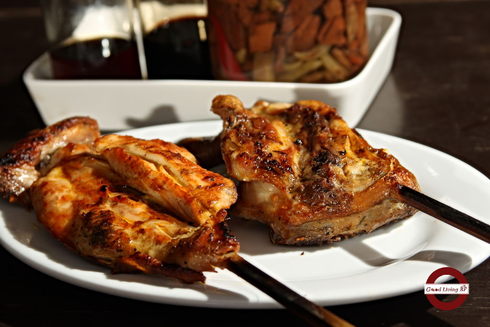 Inasal - Pecho
Cat and I sampled the signature Kansi, the indispensable Iloilo/Bacolod favorite Chicken Inasal, Pork Barbecue and the Sizzling
Sisig. First stop, the Kansi: we opted for the Kansi Laman (meat), an all-meat version, rather than the Bulalo (bone marrow) - I've been taking in too much cholesterol lately! On my first spoonful of soup I could already tell this beef had been lovingly boiled into submission over a slow fire, the flavor was so rich. Because we'd been shooting the other dishes the soup had gone cold, but Enri gave us fresh broth to bring our bowl of kansi back to steaming the way it should be enjoyed. The beef was very tender, and Cat, who usually takes her boiled beef with some kind of sauce, found she needed to add nothing at all as Enri smilingly advertised. Me, I'm the guy who always likes fire on the palate so I used the provided calamansi, fresh chilies and soy sauce to make a hot dip. Either way it went down great (had to try Cat's version too!).
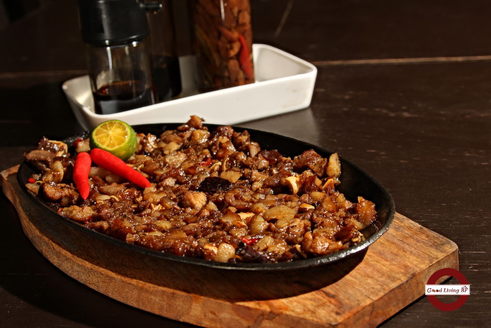 Sizzling sisig
The Inasal tasted just like those we had in Bacolod, smoky and tangy, while the Pork Barbecue was garlicky-sweet like the barbecue I grew up with. Both went down very well, though I found a bit more gristle than I liked on one stick of the barbecue. The Sizzling Sisig was a wow - really spicy the way I liked it, spiked with chopped chilies and fried to a crisp on a hotplate.
You'd expect a place that serves sisig like this to be a beer drinker's haven as well, but here we found another unique aspect of Pat Pat's Kansi: in line with its original concept as a down-home, family-friendly place, alcohol simply isn't on the menu. And because the owners want to keep the focus squarely on their strongest suits, the menu is restricted to only ten dishes, which if the four items we sampled are any indication they do really well indeed.
 Pork BBQ
Speaking of menus, the place has been discovered by a new market--our Korean visitors. A Korean traveler stopped by last year and found the food to be very much in line with the Korean taste. So determined and enthusiastic was he to recommend Pat Pat's Kansi to his compatriots that he insisted to draw up a testimonial right there and then, which the Rodriguezes printed on a banner, and they now also have a menu with entries in Korean script.
Pat Pat's Kansi BF Homes branch is located at the lower level of Greenworld Plaza along President's Avenue. The place has ample parking, a requirement which Enri says the franchisors wisely made a prime requirement. The restaurant is Enri's first venture into the food business, and it's one he made based on his good relationships with the franchisors and his belief in the product. As he narrates, he took his wife Lea to sample the Kansi, and she was sold on the idea immediately. I have to say, after the first try we're sold on Pat Pat's Kansi too.
We've just discovered a new Japanese street food place along President's Avenue. It's called Kushiten, which in my fractured understanding of Japanese boils down to 'heaven for everything on a stick.' If you've a hankering for yakitori, this is the place to find it -- about a dozen varieties of it, and all of them made with an authentic, light Japanese touch.
Kushiten's secret weapon is owner/chef Kath Kaneko and her culinary blue blood - her father is a Japanese chef and their family used to own the Keiyu Japanese restaurant in Phase 3. Kushiten's menu is a reflection of what Kath herself loves most in Japan, its variety of skewered street foods. The menu was inspired by a street stall that she always visits when she goes to Tokyo. Banking on the Filipino's love for grilled and fried dishes, Kath designed Kushiten to showcase the streets of Tokyo's best in a casual, relaxing atmosphere that welcomes Japanese expats and Filipino barkadas and families alike.
 Left Photo (l-r): Tebasaki, Tsukune, Buta Aspara. Right Photo: Momo and Negima When I order yakitori, I usually know what to expect: tender bits of sweet-salty chicken on sticks. That's it. In Kushiten, though, there's a lot more to it than that. Cathy and I sampled Momo (chicken dark meat), Tebasaki (chicken wings), Tsukune (balls of ground chicken), Negima (chicken with leeks), and Buta Aspara (thin strips of pork rolled around fresh asparagus tips). I have to say Kath has a very light hand with her marinades, so you can savor every nuance of the ingredients' flavor without them being overwhelmed in sweetness or the saltiness of soy sauce. I can see why the Japanese expats eat here.
The yakitoris went very well with a bowl of Chahan, Japanese fried rice.
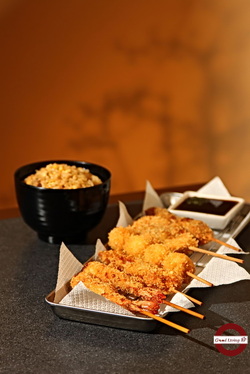 (From bottom) Kushiages - Ebi, Gyu, Uzura Tamago, Sakana, Ika After the yakitoris we tried a variety of kushiages, namely the Gyu (beef), Ika (squid), Sakana (fish), Ebi (shrimp,) and a surprise, the Uzura Tamago (quail eggs). By default these are served with a sweet kushiage sauce, but Kath also urged us to try them with tartare sauce and her own Kushiten sauce. One of the draws here, she explained, is that you can order kushiage with the sauce of your choice, including chili mayo and wasabi mayo if you want a hot kick. Cat and I found that each kushiage tends to go best with a different sauce -- the tartar was great with the fish and squid; I found the Kushiten sauce was fantastic with the quail eggsl and the sweet kushiage sauce went very well with the beef. If you're going to bring kids here, the kushiages are guaranteed to be a hit with them! Trust me - I'm very in
touch with my inner kid.
We also had a plate of fried Gyoza, an all-meat dumpling, again with Kath's own gyoza sauce. Cathy's a gyoza connoisseur, almost never failing to order it when we eat Japanese; so when she says she likes a gyoza, I know we're going there again. As for me, I liked that the gyoza sauce here has more ginger and is less sweet than usual; I find that it brings out the taste of the gyoza filling better. We then had our vegetables in the form of an Okonomiyaki, a sort of savory pancake made with shredded cabbage and topped with a light, sweet sauce, Japanese mayo, seaweed flakes and dried bonito flakes. This dish is surprisingly hefty, and can make a filling snack on its own or be a good side dish to go with the light yakitoris and kushiages.
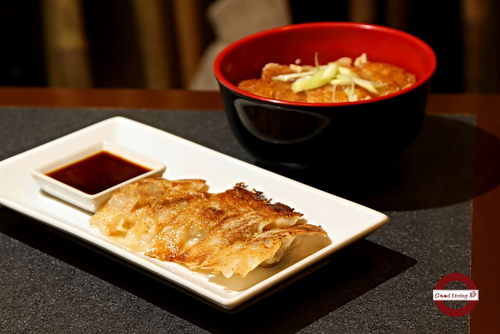 Gyoza and Katsudon As there's inevitably one big eater in every group, Kushiten is coming out with a line of donburis, or rice topping bowls, by next week. We got a sneak preview of the Katsudon, a breaded pork cutlet on rice. Kushiten's katsudon comes in a rather large serving, and is drenched in a special sauce that adds juiciness to the fried pork and makes the rice really savory. I guess this is the Japanese version of comfort food, so comforting I didn't want to get up from my chair anymore after I finished it! This friendly place with its delicious, authentic and surprisingly budget-friendly Japanese food is going to be among my top recommendations from now on.
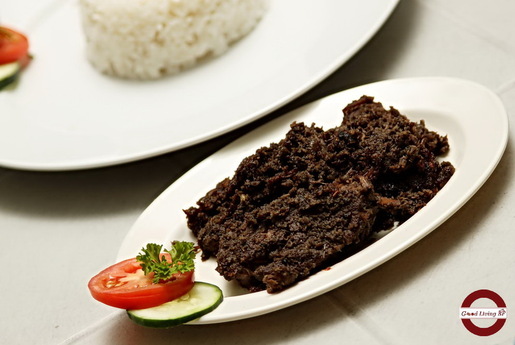 Rendang One of my happiest food-tripping memories is of the morning Cat and I spent munching our way down Jakarta's Sabang foodie district. Since then I'd have a craving ever so often for some hot Indonesian food. Now there's an answer to my cravings just five minutes walk from my house.
The newly-opened Pawon Ageng, which owner Ng Sardjono tells me means 'Big Kitchen,' occupies a two-lot property on the corner of Djakarta (what a coincidence) and El Grande; I literally pass it every time I go to work. First impressions: from the distinctive decor and the extensive menu advertised on banners outside, I was guessing the owner was either a Filipino who'd stayed long enough in Indonesia to go native, or more likely a real Indonesian. Bingo - the owner is indeed an Indonesian, married to a Filipina (and a Locsin from Silay City at that, which means she and Cat may even be related; talk about surprises!). The facilities are not air-conditioned, (they are now; with an al fresco dining at the front) but pleasantly laid out across a spacious patio and the interior of the property's original bungalow. And good news for customers -- this restaurant has parking enough for a dozen or so cars.
I arrived before Cat, having come straight from work, and being extremely hungry, I immediately ordered some Sate Ayam Madura. I got five sticks of very tender chicken, smothered in freshly-made peanut sauce with real crunchy peanuts. A definite winner, and necessitating an immediate order of San Mig Lite. In a way, that makes this place a level up from Sabang - I can get San Mig! And how was the sate? It didn't survive long enough to be photographed! As a side note, this sate isn't hot, so it's a safe order for kids and the spice-fearing among us.
 Ayam Goreng Mentega Once Cat and my dad arrived -- one of the few occasions we were able to tease Dad into going out with us -- we polished off the remaining sate and ordered our main meal. We tried the Tahu Isi, a sort of beancurd fritter fried to a crisp golden brown and stuffed with mixed vegetables; the classic beef Rendang, a beef curry cooked until its coconut cream-based sauce dried into a nutty, slightly smoky-tasting crust; Ayam Goreng Mentega, fried chicken in Indonesian-style lemon butter sauce; Udang Bakar, prawns dredged in sweet kecap manis before being barbecued in their shells; and Cah Kangkung, a fiery stir-fried kangkong dish. Though Pawon Ageng's five kinds of Nasi Goreng, Indonesian fried rice, were among its best-sellers we opted for plain
rice to get the full savor of our viands.
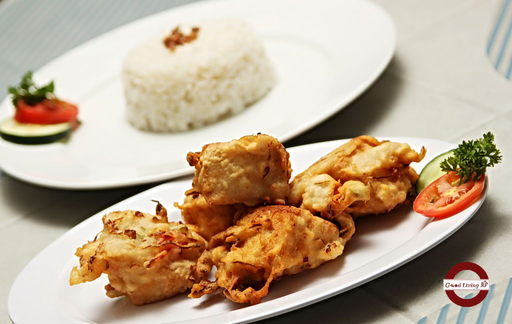 Tahu Isi We all loved the Tahu Isi, relishing the freshness of the tofu and its crunchiness. Definitely great beer food, and not too spicy by itself (I dipped mine in one of the chili-onion-soy dips provided with the prawns). The Ayam Goreng Mentega is also safe for those with low chili tolerance, a hearty and familiar-feeling dish with a lemon butter sauce that is flavorful yet not overly rich. Cat and I liked the flavor of the Udang Bakar, but it seems the way it was cooked made the shells stick to the flesh and a bit hard to peel off. (Mr. Sardjono explained that the prawns have to be cooked in their shells to avoid burning them.) I really enjoyed the Cah Kangkung, its heat a pleasant surprise -- I was crunching slices of red chili with almost every bite. Yum!
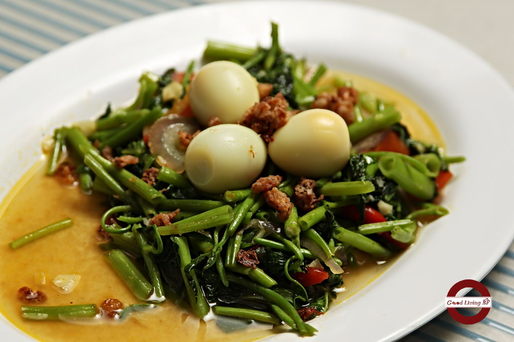 Cah Kangkung The star of the show for us though was the Rendang. This was real rendang the way I remembered it from our Jakarta trip, cooked to dry nutty crustiness, its flavor a complex cascade of exotic Indonesian spices. On finishing our dinner, we found out some of the secrets behind this heavenly rendang from Ng and his son, Lawrence. Pawon Ageng is all about delivering an authentic Indonesian experience, Lawrence says, and so dedicated to this cause are the Sardjonos that they even grow some of the necessary ingredients in the restaurant's gardens and at their home. What they can't grow or source locally, they bring in through a family member who regularly visits Jakarta. No wonder then that we cleaned our plates.
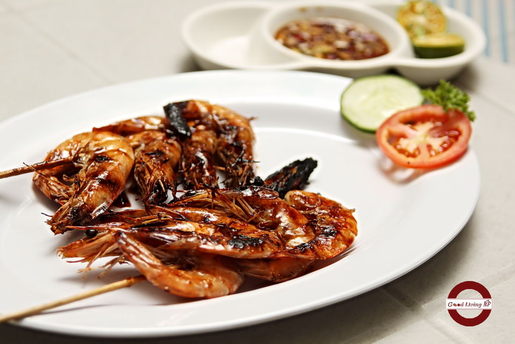 Udang Bakar Pawon Ageng opened in October 2010, and since then has been attracting a small but steady stream of customers specially in the evenings when the garden dining area is at its best. The Sardjonos are slowly adding more treats from their homeland as the business grows, so expect to be able to savor yet more exotic treats here in the future. The funny thing about our visit to Pawon Ageng? Dining here didn't quell my craving for Indonesian food -- it's sharpened it! Terima Kasih, Mr. Sardjono!
Addendum:
I got to visit Pawon Ageng last Friday to meet a friend, and driven by curiosity, I ordered one of the dishes marked on the menu as very hot. This was the Ayam Goreng Rica Rica, pronouched "richa-richa," a fried leg quarter of chicken smothered in a sauce of sauteed fresh tomatoes, onions, spices and chilis. Fire in the hole! Lawrence, son of Ng Sardjono and manager of the restaurant, assured me what I got served was a somewhat tamed version of the dish, with less chilis than what they normally have. Still, it was hot! It was good! And did I say it was hot? I'm now putting this dish on my personal list of comfort foods. The sauce was rather reminiscent of a traditional Pinoy sarciado, the tomatoes fried until they into a flavorsome paste, but with that unmistakably Indonesian blend of spices. Tip: if you're going to order this one, order a milky fruit shake or have ice cream or froyo afterward; the milk will put out that fire.
|



























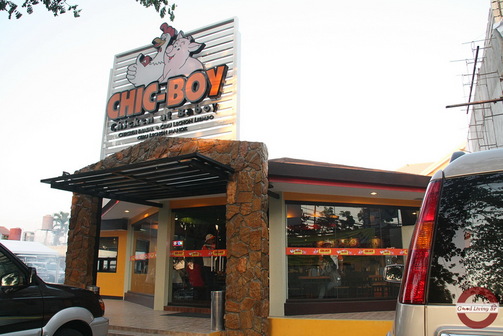








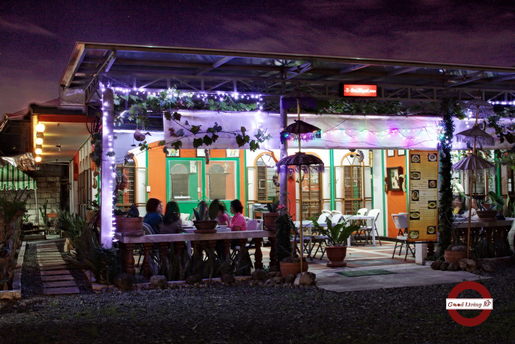




 RSS Feed
RSS Feed